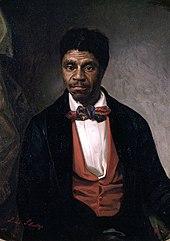Dred Scott
Dred Scott (* around 1799 , † 17th September 1858 ) was an American slave , of the famous Dred Scott v.-Sandford - Process sued unsuccessfully for his freedom. His lawsuit was based on the fact that he and his wife Harriet had resided in US states and territories where slavery was prohibited, including Illinois and parts of the Louisiana Purchase . The court ruled 7-2 against Scott on the grounds that slaves were property and that owners of their property should not be disposed of, except through constitutional, legal intervention ( 5th Amendment to the US Constitution ). Another reason was that in order to be able to file a lawsuit at all, one would need American citizenship . At that time, however, black slaves were regarded as the private property of their owners and thus had no right to citizenship. This process was an important step in the chain of events that led to the civil war .
The life of Dred Scott
Dred Scott was born in Virginia in 1799 as property of the Peter Blow family. In 1830 he moved the Blows to St. Louis , where they sold him to Dr. John Emerson, a United States Army doctor , sold. Emerson made frequent trips to Illinois and the then Wisconsin Territory - there slavery was prohibited by the Northwest Ordinance . During these trips, both Scott and Emerson met their future wives. Scott was married to Harriet Robinson and Emerson to Irene Sanford; Due to a typographical error on the part of the officer in charge, the case was recorded under the name Sandford . The Scotts returned to Missouri with the Emersons in 1842, where Emerson died the following year. The widow's brother, John FA Sanford, administered Emerson's estate .
Scott filed his motion in court in 1846; the first instance was heard in a St. Louis court house in a Missouri state court in 1847. His litigation and attorney fees were funded by his former owners, the Blow family. They failed in the first trial, but since some of the evidence presented was hearsay, the presiding judge granted them a second trial. In 1850, a jury decided that the Scotts should be freed under the so-called Missouri doctrine of "once free, always free". Emerson's widow appealed. Two years later, the Missouri Supreme Court overturned the lower court ruling on the grounds that "The times are not now what they were when the earlier decisions on this matter were made." The Scotts were consequently re-established as their movable property Classified owner.
The Scotts then filed another lawsuit, this time in federal court in St. Louis and with new lawyers. When they lost that trial, they appealed to the Supreme Court of the United States . In 1857, Chief Justice Roger B. Taney read out the verdict, with the majority held that slaves had no right to liberty, that they were property and not free citizens, that they were therefore not eligible to petition in federal courts , and that their owners were not may be expropriated by the federal government because of their place of residence. The latter principle represented a de facto repeal of the Missouri Compromise .
After the case was resolved, Scott was transferred to its original owners, the Blows. They granted him his freedom less than a year and a half before his death. Dred Scott was buried in Calvary Cemetery in St. Louis.
Web links
- Missouri's Dred Scott Case, 1846-1857 . A biography published by the Missouri state government
- United States Supreme Court: Dred Scott v. Sandford (1856) . Full text of the reasons for the judgment of December 1, 1856 from FindLaw (English)
- Dred Scott v. Sandford . Thematic resources on the website of the Library of Congress (English)
- Dred Scott . Website " Mr. Lincoln and Freedom" of the Lehrman Institute (English)
- Dennis-Jonathan Mann, Kai P. Purnhagen: The Nature of Union Citizenship between Autonomy and Dependency on (Member) State Citizenship: A Comparative Analysis of the Rottmann Ruling, or: How to Avoid a European Dred Scott Decision? Application of the Dred Scott ruling to the ECJ case law on EU citizenship, November 24, 2011
| personal data | |
|---|---|
| SURNAME | Scott, Dred |
| BRIEF DESCRIPTION | American slave |
| DATE OF BIRTH | around 1799 |
| DATE OF DEATH | September 17, 1858 |

